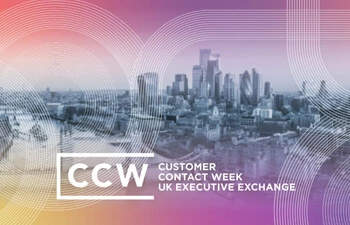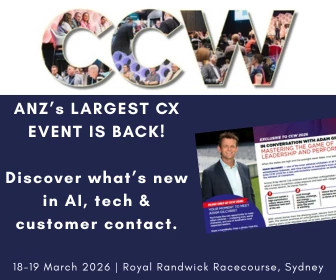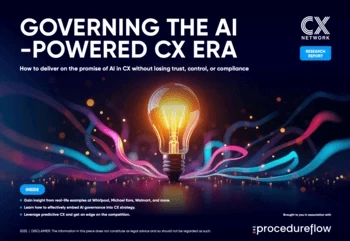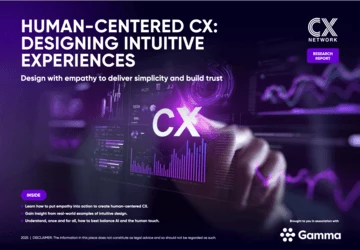How to navigate the hype around AI
With new capabilities entering the market every quarter, it’s easy to get caught up in the excitement, but when it comes to AI, the best results come from taking a step back
Add bookmark
Every new technology grows along the “S-curve”. Whether it’s mobile phones, voice search or VR glasses, things start slow, gain momentum for a period of rapid growth, then plateau. Much has been written, recorded and said about the S-curve of AI adoption and it is widely accepted that we are currently in the mid-phase of rapid growth.
But growth is driven by interest, and it is here that hype takes hold.
Hype is a different kind of beast. And, when taken at face value, it can easily lead to misdirected investment, misaligned objectives and customer journey misfires.
When it comes to AI in CX, there are hundreds of solutions on the market, and each one is progressing through its own S-curve, driven by claims that don’t always ring true in the real world. As a result, CX leaders are tasked with working through the hype, assessing their own organizational needs and deciding which technologies are worth – and not worth – a piece of their limited budgets.
Following on from our insights on how to avoid the (general) hype in CX, this article focuses specifically on how to navigate the hype that exists around AI, how to make thoughtful investments in the face of claims that promise to solve every problem under the sun, and how to keep humans at the center of CX.

Don't miss any news, updates or insider tips from CX Network by getting them delivered to your inbox. Sign up to our newsletter and join our community of experts.
Ignore distractions, deliver outcomes
When it comes to artificial intelligence (AI), particularly in experience management, the hype is inescapable and this creates a whole new problem for CX leaders who need to enhance journeys while meeting organizational needs.
“AI, and all the amazing ways it can help us accelerate and quantify results, is crucial for CX leaders to leverage,” says Jeannie Walters, award-winning CX expert, international keynote speaker and founder of Experience Investigators.
“But if you don't have a real strategy and intentional definitions of success, these hype machines become distractions,” Walters adds.
Simon Hayward, GM and VP of sales, international at Freshworks, echoes her point. “The focus shouldn’t be on chasing the hype, but on delivering measurable outcomes such as improved resolution times, simpler customer journeys, or more empowered teams,” he says. “When AI is deployed thoughtfully, it stops being a buzzword and instead becomes a seamless part of how great service gets delivered.”
Many agree with these words.
Jason Bradshaw, keynote speaker, consultant and founder of the Power Of CEX consultancy, says the “greatest danger in 2026” is the over-reliance on AI as a cost-reduction tool or silver bullet.
“While agentic AI and personalization technologies are powerful, chasing them without clarity of purpose leads to sterile, less differentiated experiences,” Bradshaw says.
“CX leaders must view every new tool through one simple lens: does this make the experience more connected, more valuable, and more aligned with our brand promise? If not, it’s just another shiny distraction.”
Nick Glimsdahl, CX expert, author and host of the podcast Press 1 For Nick, says the key to proving the value of AI is to ground every investment “in measurable experience outcomes, customer satisfaction, resolution speed, and employee enablement”.
“In 2026, leading CX teams will separate signal from noise by linking every investment to a clear human or business outcome. That starts with using the right level of AI; not every problem calls for agentic capabilities. Avoid tools that sound impressive but add friction or confusion. The real differentiator won’t be who adopts AI first; it’ll be who applies it with honesty, clarity, and purpose,” Glimsdahl adds.
Speaking specifically about agentic AI, Jaslyin Qiyu, CMO and head of CX in Singapore and Australia for Cigna Healthcare, says: “Shiny AI platforms promise seamless agentic deployment. The reality involves data integration nightmares, process redesign, change management resistance, and regulatory complexity.”
As a result, Qiyu advises practitioners to budget for “the hidden costs of making systems actually work within your existing architecture”.
Ashlea Atigolo, managing partner at Consult Venture Partners and co-founder at INATIGO, adds that governance and transparency must also lead every project. “AI consent must be built into the customer journey rather than hidden in policy,” Atigolo says.
“Keeping humans visible in the loop protects empathy and stops automation from feeling faceless. The most credible CX leaders will show that trust, not speed, is what keeps innovation sustainable,” she adds.
Although it feels like there is always a “shiny new thing” in the world of AI, hype doesn't last forever and, at some point, the dust always settles. It is here, says author Peter Cross, that businesses will begin to realize AI doesn't automatically equate to great outcomes and satisfied customers.
“The hype of artificial intelligence will ease as businesses move from tests and pilots to adopting the new technologies as ’business as usual’. Business will also begin to realise it isn't going to be the panacea or silver bullet able to fix broken customer experience,” Cross says.
"Used wisely, AI will do great things to make business easier, more informed and more efficient. Used blindly without the appropriate checks and balances to ensure the customer (or front line employee) is genuinely benefiting, it could lead to a further decline in global customer satisfaction,” he adds.
Know how AI fits in with your strategy
Part of seeing through the hype is being able to decipher which technologies are gimmicks, which technologies are impressive but not the right fit for your organization, and which are likely to be relevant to your organization and its objectives.
We know customers grow frustrated with bad bots, but better technology won’t automatically address this problem. Chatbot solutions, for example, still need to be thoughtfully designed and introduced at an appropriate place in the customer journey.
Cross says: “Inauthentic or artificial use of technology – such as calling a one-dimensional chatbot Sue to pretend that it is human – will feel outdated before too long.”
He adds: “The game changers will be those who recognize that the real change will come not just from the AI itself, but from considered and thoughtful execution and deployment of the new technologies.”
Qiyu says: “If your CX strategy begins with ‘how should we implement AI’, you’re missing the point. Identify where customers experience genuine friction, where service costs spike, where satisfaction drops. Technology becomes the enabler, not the objective or end goal.”
She says deflection rates and automation percentages explain nothing about customer value creation. Instead, practitioners should “track resolution quality, effort scores, retention impact, and lifetime value shifts”.
She adds: “The metrics reveal whether you're optimizing experiences or merely digitizing dysfunction.”
Keep people front of mind when implementing AI
The human in the loop is crucial – and not just for oversight and governance. Founder and CEO Raluca Berchiu says practitioners must retain a laser focus on how the introduction of AI impacts humans throughout the chain.
“Investors demand immediate results. Employees whisper about whether their roles will exist in five years; economic headwinds are forcing executives to do more with less; and every dollar spent must deliver measurable impact,” Berchiu says.
“Yet despite this urgency, and the billions poured into technology, most transformations still fail. It is estimated that 80 percent of AI projects never scale beyond pilots and Harvard Business Review has long observed that 70 percent of large-scale transformations miss their intended outcomes,” she adds.
The uncomfortable truth, she says is that “it is rarely the technology that breaks. It is the people.”
“In an AI-driven world, the human advantage is the only sustainable differentiator,” she adds.
Mamonova advises organizations adopt AI to augment human judgment, not replace it. “Use AI for low-complexity, transactional tasks and route complex cases to people, surface AI suggestions to agents with explainability and confidence scores, and measure success by customer‑centric KPIs such as post‑interaction satisfaction and resolution rates rather than cost deflection,” she explains.
Digital customer service and culture advisor Paolo Fabrizio says organizations that “forget about the customer” when implementing generative AI in particular, will pay a heavy price when it comes to churn.
“In fact the hype to avoid is not AI per se, it is underestimating customers’ super high expectations on AI in terms of smoother CX, especially in faster responses and lower efforts,” he says.
Fabrizio advises organizations to monitor their competitors to see how they use AI to improve workflows and staff productivity. “Stick to your goals and, most of all, to your customer culture. That’s your North Star,” he says.
Scope and timing are also crucial. Ledi Lapaj, director of CX at Bank-al-Etihad says: “Over-automation or premature deployment can compromise empathy, trust, and data privacy.”
She advises CX leaders to adopt a phased approach, “starting with AI as a copilot to assist human agents before customer-facing autonomy”, she says.
“Especially in sensitive sectors like finance, AI should first manage inquiries and complaints, and only later advance to transactional decisions once reliability, compliance, and ethical safeguards are firmly in place,” she adds.
Finally, don’t forget your employees.
Babul Balakrishnan, head of CX operations for Thunes, says organizations should use AI to make employees happier. “Invest more in fixing systems and providing tools and empowerment to your teams to make decisions faster,” he says.
“The new mantra for AI should be ‘adaptive innovation’. AI isn’t about algorithms outsmarting humans. It’s about giving humans the space to do what we’re uniquely good at – lateral thinking, empathy, and creativity,” Balakrishnan adds.
Montserrat Padierna, customer insights and analytics lead for Walmart Canada, is passionate about the value mid-career professionals who grew up in the analogue world bring to business. She calls them Weavers, “those who understand context, ask the right questions, and continuously refine models so that AI serves real operational goals, not theoretical innovation”.
Their role, she says, “is to translate insights into influence, guiding teams toward actions that move KPIs, not dashboards”. When it comes to artificial intelligence, they have a unique role to play.
“Constant human input keeps AI grounded in truth, avoiding hallucinations and irrelevant outputs,” she adds.
Final thoughts
Powerful technologies can deliver a lot, but it takes human intelligence to know where they are most suitable and relevant, and where they are likely to drive the biggest impact.
As our panel of experts advise, it is of paramount importance to ensure that AI is implemented to solve an existing need; that it is thoughtfully integrated to work alongside humans; and that at no point should it be used without human oversight. Governance, transparency, and constant refinement are also required.
Behind the scenes, AI requires clean, accessible, and dependable data and this comes with its own costs - both financial and reputational if due diligence is lacking.
It's safe to say there are many ways AI can improve CX, and as the S curve plateaus, successful use cases will proliferate. Pathways already exist for those who want to lead the way, but as Padierna says: “The organizations that succeed will treat AI not as an oracle, but as a disciplined system refined by human judgment and business reality.”
Quick links
- CX trends in 2026: 10 ways generative and agentic AI will change the game
- CX trends in 2026: How to avoid the hype and drive real-world results
- The top 10 CX podcasts to listen to in 2026
All Access: Future of CX 2025

Join us to hear from industry leaders, innovators, and CX experts as they share insights, strategies, and tools for harnessing customer feedback to drive meaningful change.
Register Now





























